|
[worked right to left][first strand in top layer] |
|
In this part of the [diagonally interlaced fingerweaving]tutorial will be worked from the right hand side of the workpiece to the left hand side of the workpiece.
[NOTE] The headstick is set up so that the first strand on the right hand side of the workpiece is in the top layer of the shed. |
[figure-1]

|
| Go to: Top of page | Next |
|
[Row 1]
Start weaving by reaching under the first strand of the top layer of the shed. Use the thumb and index finger to pick up the second strand of top layer of the shed. |
[figure-2]
[click here to see video]

|
| Previous | Next |
|
[Row 1]
Pull the second top layer strand over the first bottom layer shed strand and under the first top layer shed strand. [OBSERVE] The over/under configuration of the first three strands. |
[figure-3]
[click here to see video]
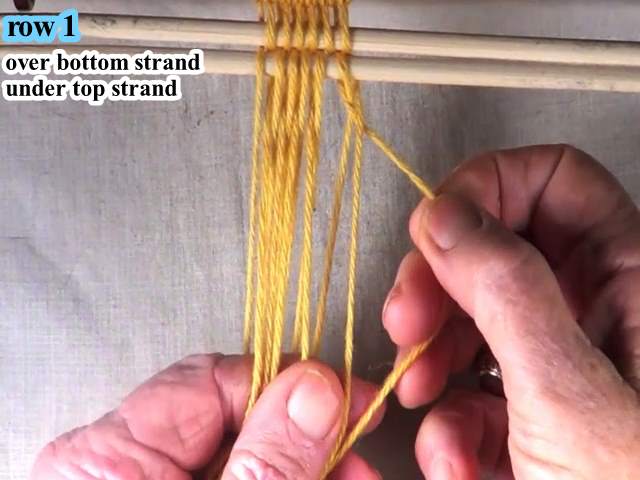
|
| Previous | Next |
|
[Row 1]
Transfer the first two strands that are now on the right hand side to the index finger of the right hand. [OBSERVE] The over/under configuration of the first two strands includes the index finger. [OBSERVE] The strand that was the first strand and in the top shed layer has been turned back into the workpiece and became a bottom shed layer strand. [OBSERVE] The top layer shed strand that was pulled to the right hand edge of the workpiece is still in the top layer of the shed (over the index finger). [OBSERVE] The next two strands are in the bottom layer of the shed. |
[figure-4]
[click here to see video]
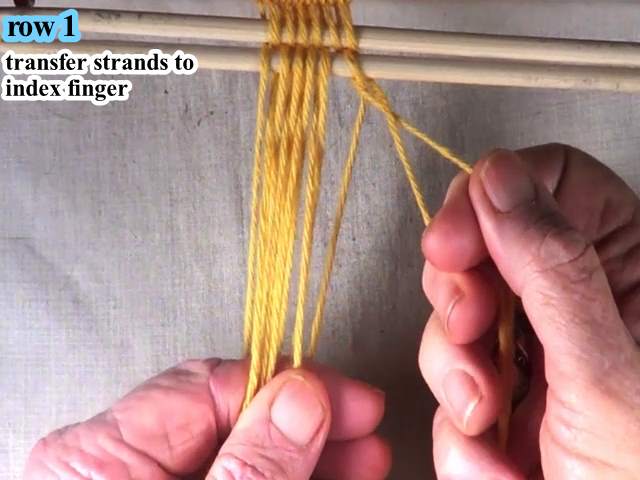
|
| Previous | Next |
|
[Row 1]
Use the thumb and index finger to reach under the first of the next two bottom layer shed strands. Then pick up the next top layer shed strand. |
[figure-5]
[click here to see video]
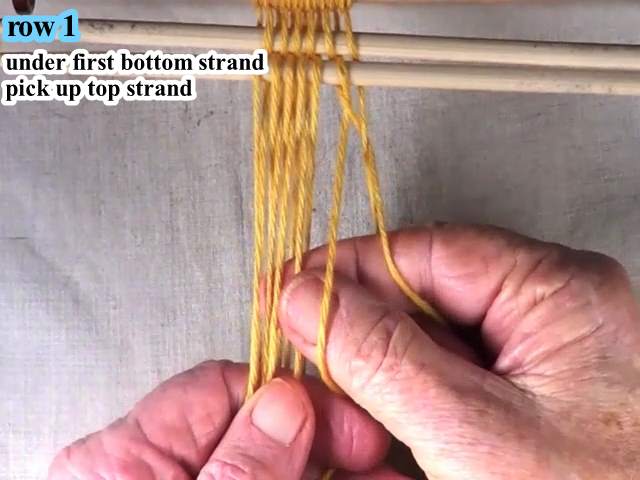
|
| Previous | Next |
|
[Row 1]
Pull the next top layer shed strand over the adjacent bottom layer shed strand and under the next bottom layer shed strand. [OBSERVE] The over/under configuration of the first five strands. |
[figure-6]
[click here to see video]
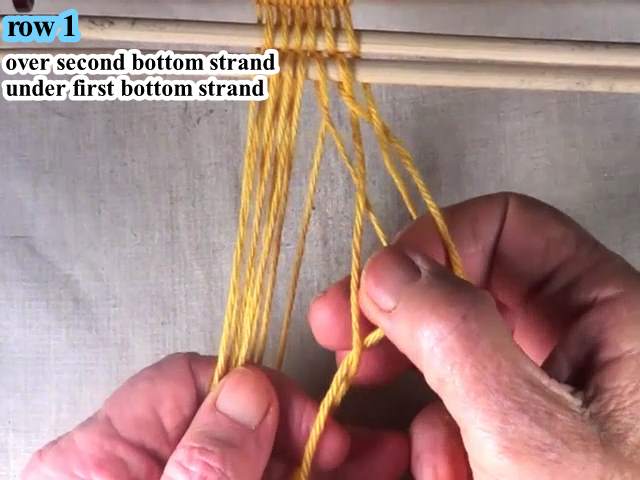
|
| Previous | Next |
|
[Row 1]
Transfer the next two strands to the index finger of the right hand. [OBSERVE] The over/under configuration of the first four strands includes the index finger. [OBSERVE] The top strand that was pulled to the right is still in the top layer of the shed (over the index finger). [OBSERVE] The next two strands are in the bottom layer of the shed. |
[figure-7]
[click here to see video]
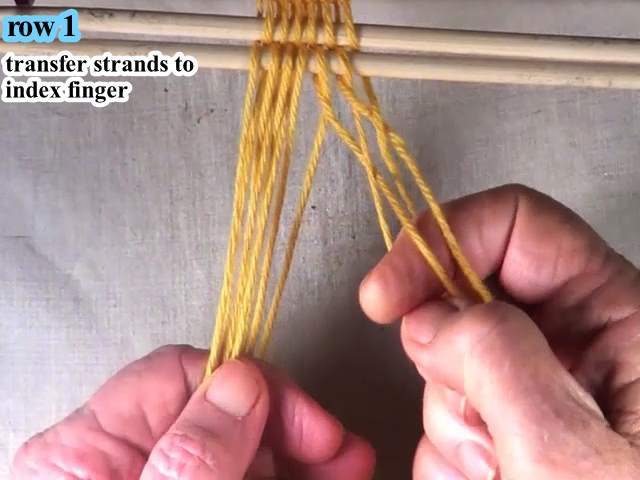
|
| Previous | Next |
|
[Row 1]
Use the thumb and index finger to reach under the first of the next two bottom layer shed strands. Then pick up the next top layer shed strand. |
[figure-8]
[click here to see video]

|
| Previous | Next |
|
[Row 1]
Pull the next top strand over the adjacent bottom shed strand and under the next bottom shed layer strand. [OBSERVE] The over/under configuration of the first six strands. |
[figure-9]
[click here to see video]
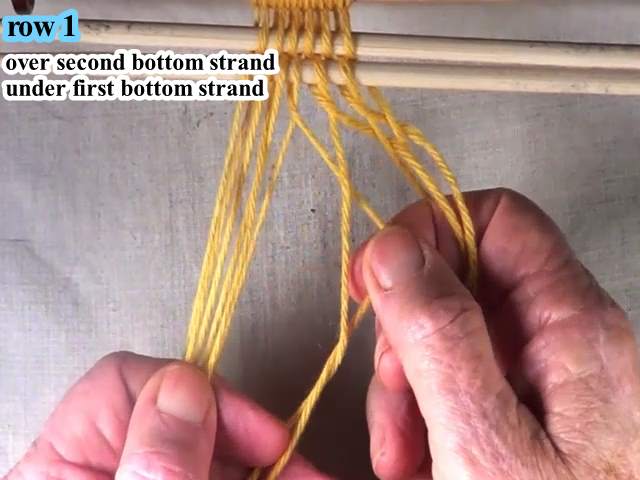
|
| Previous | Next |
|
[Row 1]
Transfer the next two strands to the index finger of the right hand. [OBSERVE] The over/under configuration of the first six strands includes the index finger. [OBSERVE] The top strand that was pulled to the right is still in the top layer of the shed (over the index finger). [OBSERVE] The next two strands are in the bottom layer of the shed. |
[figure-10]
[click here to see video]
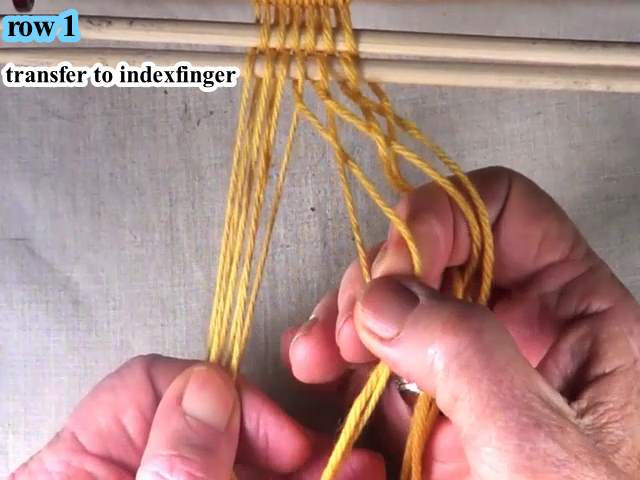
|
| Previous | Next |
|
[Row 1]
Use the thumb and index finger to reach under the first of the next two bottom layer shed strands. Then pick up the next top layer shed strand. |
[figure-11]
[click here to see video]
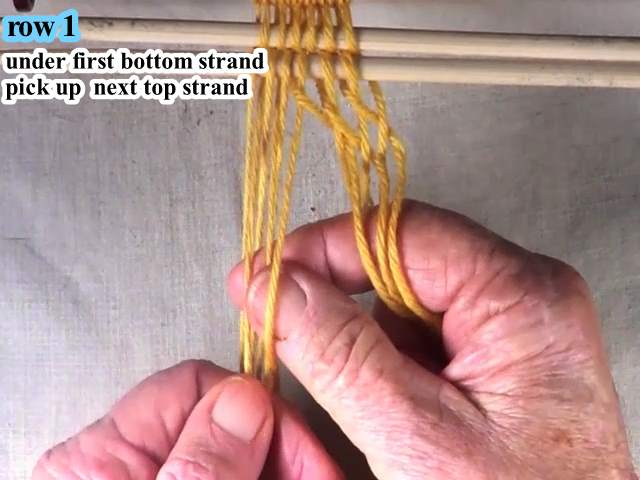
|
| Previous | Next |
|
[Row 1]
Pull the next top strand over the adjacent bottom shed strand and under the next bottom shed layer strand. [OBSERVE] The over/under configuration of the strands held by the right hand. |
[figure-12]
[click here to see video]
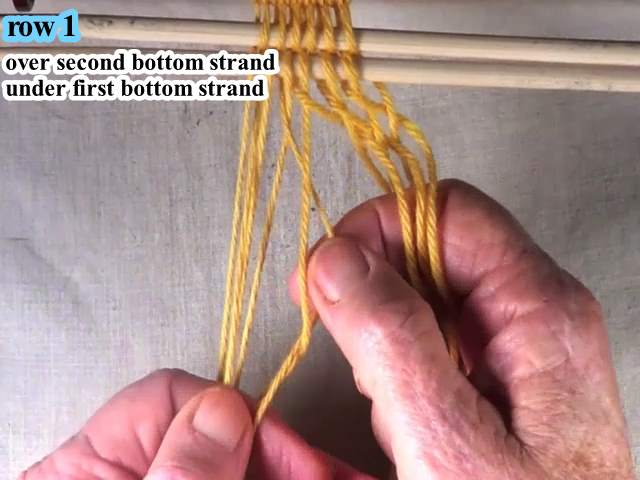
|
| Previous | Next |
|
[Row 1]
Transfer the next two strands to the index finger of the right hand. [OBSERVE] The over/under configuration of the strands held by the right hand includes the index finger. [OBSERVE] The top strand that was pulled to the right is still in the top layer of the shed (over the index finger). [OBSERVE] The next two strands are in the bottom layer of the shed. |
[figure-13]
[click here to see video]
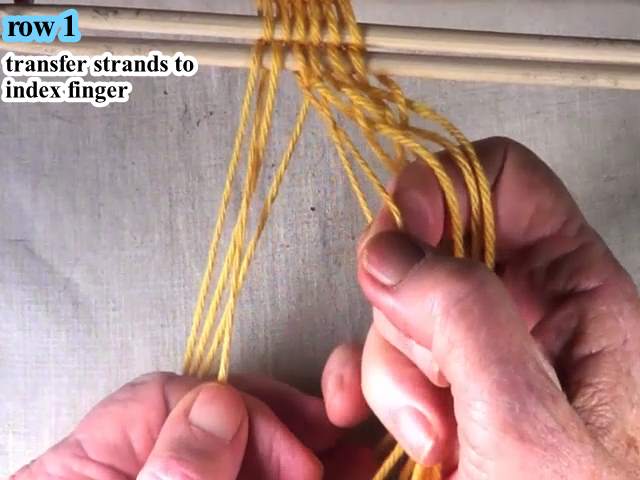
|
| Previous | Next |
|
[Row 1]
Use the thumb and index finger to reach under the first of the next two bottom layer shed strands. Then pick up the next top layer shed strand. |
[figure-14]
[click here to see video]

|
| Previous | Next |
|
[Row 1]
Pull the next top strand over the adjacent bottom shed strand and under the next bottom shed layer strand. [OBSERVE] The over/under configuration of the strands held by the right hand. |
[figure-15]
[click here to see video]

|
| Previous | Next |
|
[Row 1]
Transfer the next two strands to the index finger of the right hand. [OBSERVE] The over/under configuration of the strands held by the right hand includes the index finger. [OBSERVE] The top strand that was pulled to the right is still in the top layer of the shed (over the index finger). [OBSERVE] The remaining two strands are in the bottom layer of the shed. |
[figure-16]
[click here to see video]

|
| Previous | Next |
|
[Row 1]
Use the thumb and index finger to reach under the first of the remaining two bottom layer shed strands. Then pick up the last botttom layer shed strand. |
[figure-17]
[click here to see video]
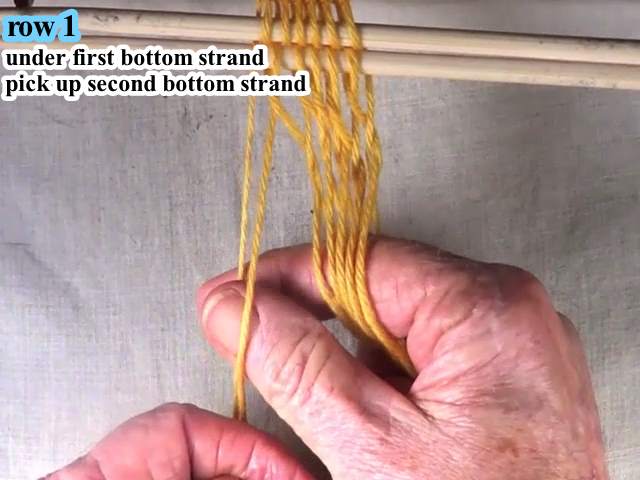
|
| Previous | Next |
|
[Row 1]
Pull the last bottom layer shed strand under the first bottom shed layer strand. [OBSERVE] The over/under configuration of the strands held by the right hand. |
[figure-18]
[click here to see video]

|
| Previous | Next |
|
[Row 1]
Transfer the last two strands to the index finger of the right hand. [OBSERVE] The over/under configuration of the strands held by the right hand includes the index finger. [OBSERVE] The last bottom strand was pulled to the right and placed over the index finger. [OBSERVE] The last strand has moved from the bottom layer of the shed to the top layer of the shed. |
[figure-19]
[click here to see video]

|
| Previous | Next |
|
[Row 1]
Set weave by pulling the layers of the shed in opposite directions and using your index finger as a beater. Check to see that all the strands are snug and even. |
[figure-20]
[click here to see video]
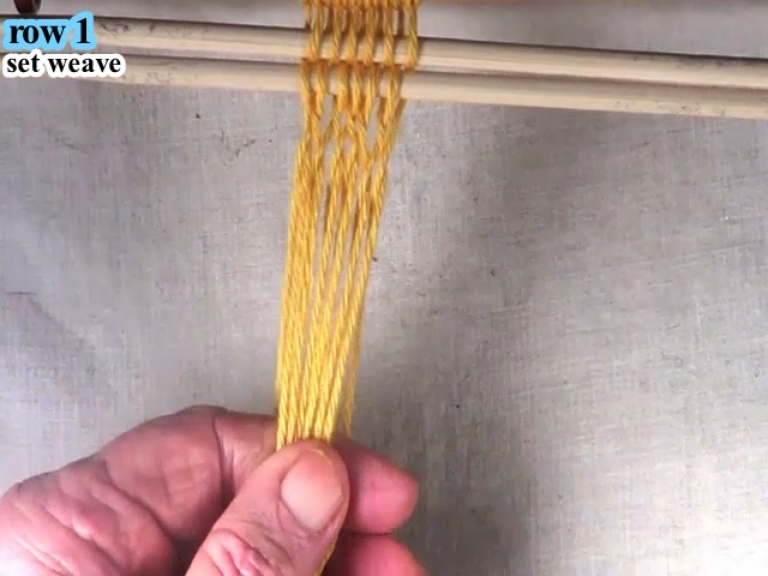
|
| Previous | Next |
|
[Row 2]
Start weaving by reaching under the first strand of the top layer of the shed. Use the thumb and index finger to pick up the second strand of top layer of the shed. |
[figure-21]
[click here to see video]

|
| Previous | Next |
|
[Row 2]
Pull the last bottom layer shed strand under the first bottom shed layer strand. [OBSERVE] The over/under configuration of the strands held by the right hand. |
[figure-22]
[click here to see video]

|
| Previous | Next |
|
[Row 2]
Transfer the first two strands that are now on the right hand side of the work piece to the index finger of the right hand. [OBSERVE] The over/under configuration of the first two strands includes the index finger. [OBSERVE] The strand that was the first strand and in the top shed layer has been turned back into the workpiece and became a bottom shed layer strand. [OBSERVE] The top strand that was pulled to the right hand edge is still in the top layer of the shed (over the index finger). [OBSERVE] The next two strands are in the bottom layer of the shed. |
[figure-23]
[click here to see video]

|
| Previous | Next |
|
[Row 2]
Use the thumb and index finger to reach under the first of the next two bottom layer shed strands. Then pick up the next top layer shed strand. |
[figure-24]
[click here to see video]
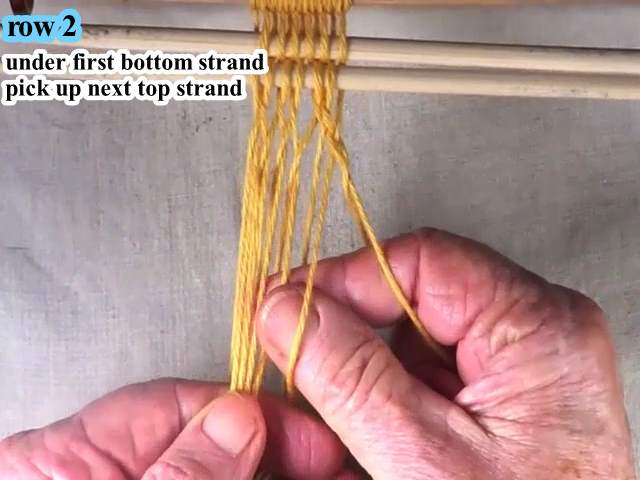
|
| Previous | Next |
|
[Row 2]
Pull the next top strand over the adjacent bottom shed strand and under the next bottom shed layer strand. [OBSERVE] The over/under configuration of the first five strands. |
[figure-25]
[click here to see video]
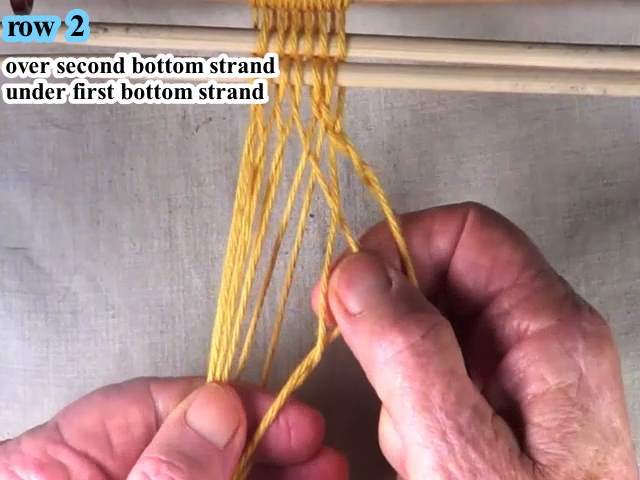
|
| Previous | Next |
|
[Row 2]
Transfer the next two strands to the index finger of the right hand. [OBSERVE] The over/under configuration of the first four strands includes the index finger. [OBSERVE] The top strand that was pulled to the right is still in the top layer of the shed (over the index finger). [OBSERVE] The next two strands are in the bottom layer of the shed. |
[figure-26]
[click here to see video]
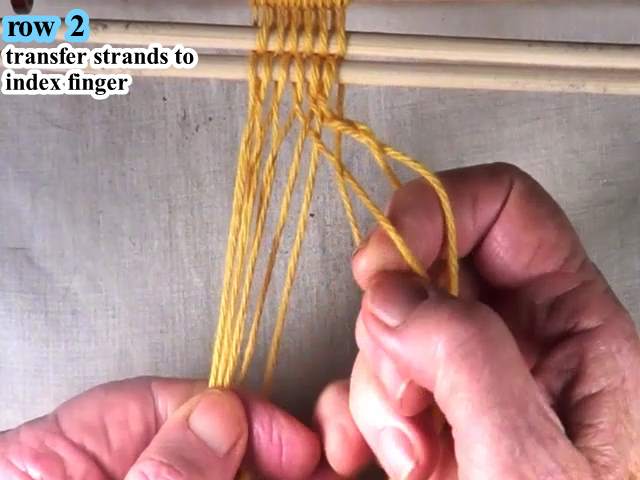
|
| Previous | Next |
|
[Row 2]
Use the thumb and index finger to reach under the first of the next two bottom layer shed strands. Then pick up the next top layer shed strand. |
[figure-27]
[click here to see video]

|
| Previous | Next |
|
[Row 2]
Pull the next top strand over the adjacent bottom shed strand and under the next bottom shed layer strand. [OBSERVE] The over/under configuration of the first seven strands. |
[figure-28]
[click here to see video]

|
| Previous | Next |
|
[Row 2]
Transfer the next two strands to the index finger of the right hand. [OBSERVE] The over/under configuration of the first four strands includes the index finger. [OBSERVE] The top strand that was pulled to the right is still in the top layer of the shed (over the index finger). [OBSERVE] The next two strands are in the bottom layer of the shed. |
[figure-29]
[click here to see video]
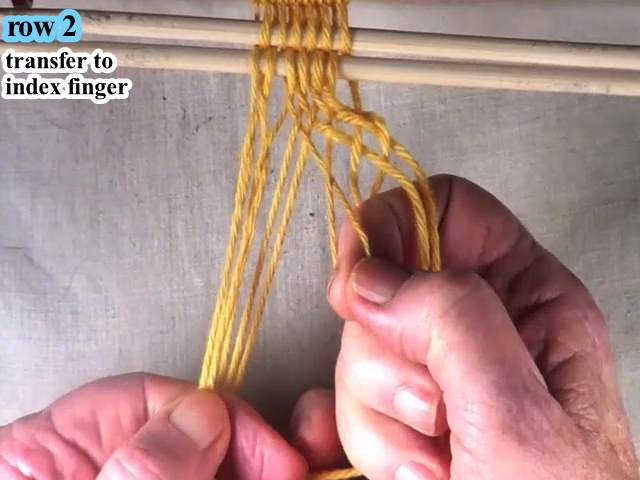
|
| Previous | Next |
|
[Row 2]
Use the thumb and index finger to reach under the first of the next two bottom layer shed strands. Then pick up the next top layer shed strand. |
[figure-30]
[click here to see video]

|
| Previous | Next |
|
[Row 2]
Pull the next top layer shed strand over the adjacent bottom layer shed strand and under the next bottom layer shed strand. [OBSERVE] The over/under configuration of the strands held by the right hand. |
[figure-31]
[click here to see video]
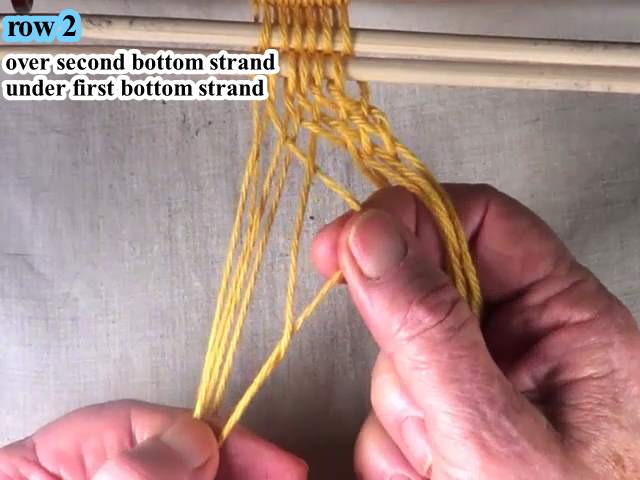
|
| Previous | Next |
|
[Row 2]
Transfer the next two strands to the index finger of the right hand. [OBSERVE] The over/under configuration of the strands held by the right hand includes the index finger. [OBSERVE] The top strand that was pulled to the right is still in the top layer of the shed (over the index finger). [OBSERVE] The next two strands are in the bottom layer of the shed. |
[figure-32]
[click here to see video]
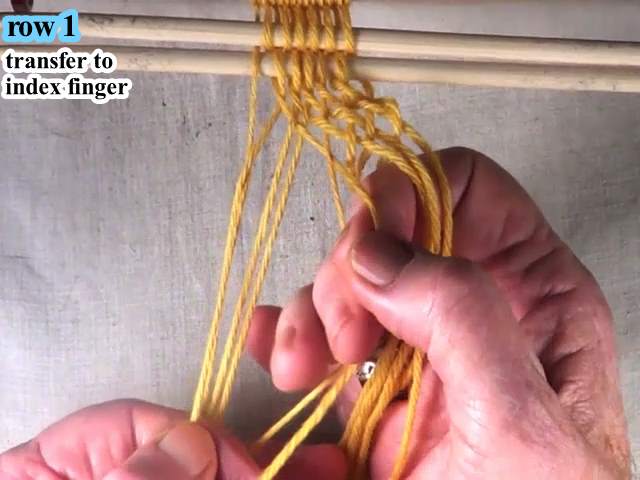
|
| Previous | Next |
|
[Row 2]
Use the thumb and index finger to reach under the first of the next two bottom layer shed strands. Then pick up the next top layer shed strand. |
[figure-33]
[click here to see video]

|
| Previous | Next |
|
[Row 2]
Pull the next top strand over the adjacent bottom layer shed strand and under the next bottom layer shed strand. [OBSERVE] The over/under configuration of the strands held by the right hand. |
[figure-34]
[click here to see video]
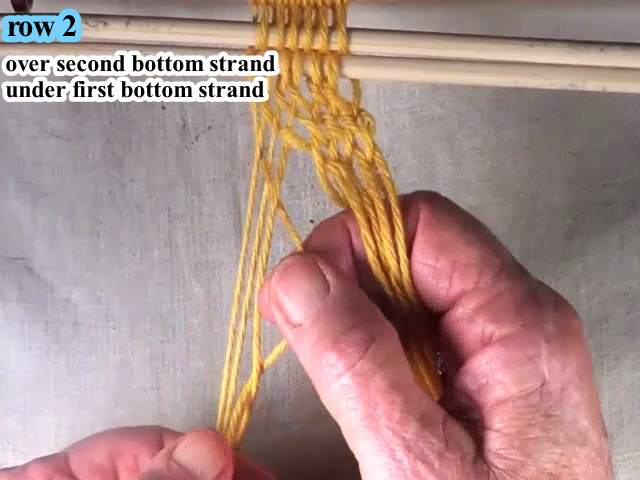
|
| Previous | Next |
|
[Row 2]
Transfer the next two strands to the index finger of the right hand. [OBSERVE] The over/under configuration of the strands held by the right hand includes the index finger. [OBSERVE] The top strand that was pulled to the right is still in the top layer of the shed (over the index finger). [OBSERVE] The remaining two strands are in the bottom layer of the shed. |
[figure-35]
[click here to see video]
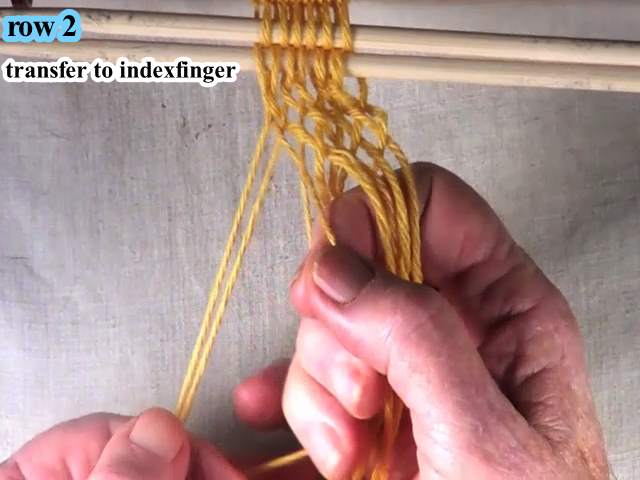
|
| Previous | Next |
|
[Row 2]
Use the thumb and index finger to reach under the first of the remaining two bottom layer shed strands. Then pick up the last botttom layer shed strand. |
[figure-36]
[click here to see video]

|
| Previous | Next |
|
[Row 2]
Pull the last (second) bottom layer shed strand under the first bottom layer shed strand. [OBSERVE] The over/under configuration of the strands held by the right hand. |
[figure-37]
[click here to see video]
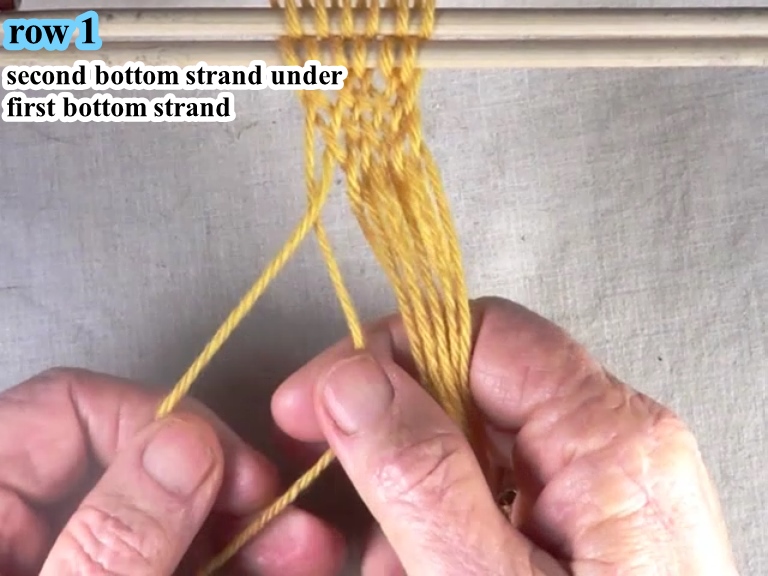
|
| Previous | Next |
|
[Row 2]
Transfer the last two strands to the index finger of the right hand. [OBSERVE] The over/under configuration of the strands held by the right hand includes the index finger. [OBSERVE] The last bottom layer shed strand was pulled to the right and placed over the index finger. [OBSERVE] The last strand has moved from the bottom layer of the shed to the top layer of the shed. |
[figure-38]
[click here to see video]
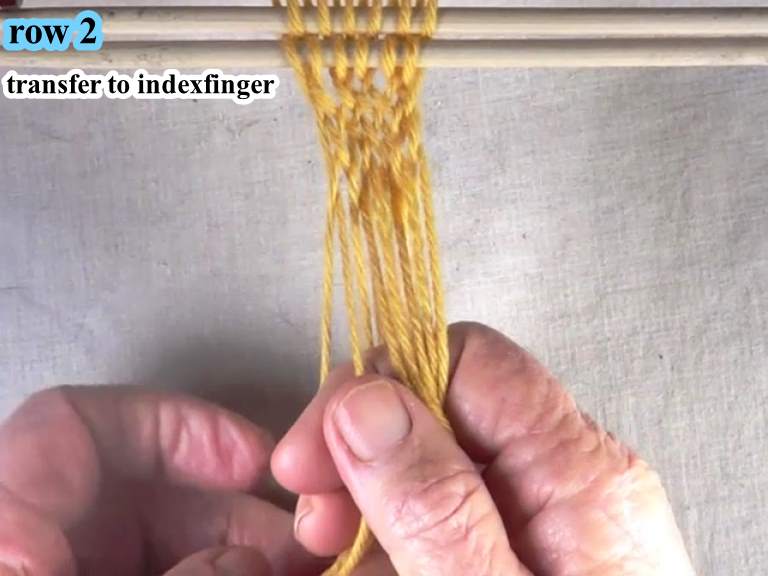
|
| Previous | Next |
|
[Row 2]
Set weave by pulling the layers of the shed in opposite directions and using your index finger as a beater. Check to see that all the strands are snug and even. |
[figure-39]
[click here to see video]
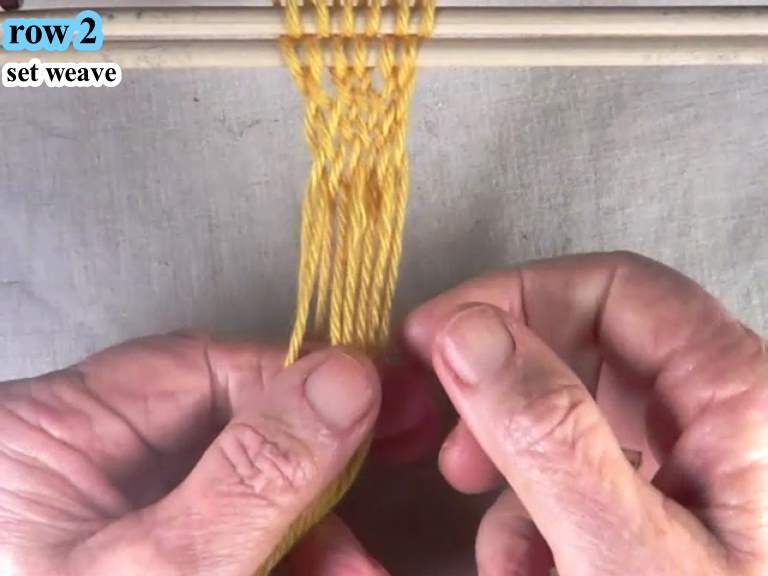
|
| Previous | Next |
|
[Row 3]
Weave row 3 by following the steps for weaving rows 1and 2. Continue adding rows of weaving untill the workpiece has reached the desired length. |
[figure-40]
[click here to see video]

|
| Previous | Go to: Top Page] |